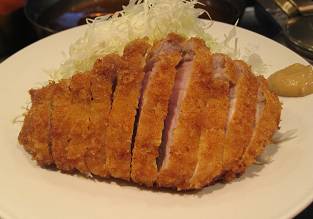Cool Japan
Japanse Soul Food "TONKATSU"
Tonkatsu is a Japanese dish which consists of deep fried, breaded and sliced pork. It is said to have been developed in Japan through many improvements on the cutlet introduced from England more than 100 years ago. °»Fried pork cutlet°… first appeared in 1899 at a restaurant called °»Rengatei°… located in Ginza, and this can be considered the start of the long history of tonkatsu. Tonkatsu is commonly eaten with a Worcestershire-style sauce called °»tonkatsu sauce,°… and is accompanied by rice, miso soup, tsukemono (pickled vegetables), and fresh cabbage. Tonkatsu is cut before being served so it can be easily eaten with chopsticks. Tonkatsu has also been adapted into other dishes, including katsudon (in which pork cutlet is soaked with egg, pan fried, and served atop a bowl of rice) and katsu curry (curry with pork cutlet).
(i)°»Renga-tei°…:
| A youshoku (western-style cuisine) restaurant in Ginza, located three minutes°« walk from exit 9 of Ginza station on the Tokyo Metro Ginza subway line | |
|
Rengatei, a famous restaurant in Ginza founded in 1895, marked its 118th anniversary in 2013. Many famous people, such as the author Shotaro Ikenami, the film director Yasujiro Ozu, and manga illustrator and animator Osamu Tezuka frequently visited this restaurant. I have been exploring simple, well-prepared cuisine (which is generally called °»B-kyu gourmet°… in Japanese) for a long time, and I believe the time has come to tackle the Ginza area.
|
 |
| My primary target was the fried pork cutlet which Shotaro Ikenami demolished three times in one day. The picture shown on the right shows a special variation of the fried pork cutlet which is twice the normal size. We initially thought that we could not possibly eat all of it as it was quite large, but it disappeared into our four stomachs in no time. It indeed had a light, simple taste. Lean meat was used. The mincemeat was also cooked with an emphasis on the flavor of the meat, and thus no bouillon was added. Rengatei°«s fried pork cutlet tasted similar to that of the restaurant named °»Mizuguchi Shokudo°… in Asakusa. In all, we had fried pork cutlet, beef cutlet, and fried mincemeat, and finally omuraisu (rice omelet). The omuraisu was cooked in the same way that it was when it was first introduced in Japan, which was very interesting. We fully enjoyed the Ginza dining experience.
| |
| °°°°MAP:http://www.ginza.jp/archives/4637?lang=en | |
(ii)°»Sugita°…: | |
|
A tonkatsu restaurant located in Kotobuki, Taitou-ku, seven minutes°« walk from Tawaramachi station on the Tokyo Metro Ginza subway line
I was dying to go to this restaurant. Their tonkatsu costs 2,000 yen. The restaurant is located in the Kotobuki district of Taitou-ku, seven minutes°« walk from Tawaramachi station on the Tokyo Metro Ginza subway line. For lunch, there wouldn°«t be enough time to fully enjoy the tonkatsu, but at the same time, I was afraid it could end up being a meal without drinks if I visited the restaurant in the evening.
|
 |
Despite my concerns, an acquaintance recommended the restaurant as a place where you can both drink and eat tonkatsu. I decided to visit the restaurant with this expectation.
Upon entering the restaurant, I took a seat at the white wood counter. In front of me were two cookpots with a lage amount of hot oil. It seemed that one of the two contained high temperature oil while the other contained low temperature oil.
I ordered the pork loin cutlet and the pork fillet cutlet. As it was being prepared, I was surprised to see that the pork loin was tremendously thick: almost 2 cm. My mind became occupied with wonder - would this cutlet really go with drinks? But I waited for the cutlets to fry while drinking Kirin lager beer. The process took quite a long time, but the cutlets were finally done after being fried in high temperature oil and low temperature oil several times in succession. The cutlets served looked identical to those shown in the picture. There were ten pieces; almost twice the number found in ordinary cutlets, which are served in about five pieces. The width of the pieces was about 1cm. I wondered why they cut the cutlets into such thin pieces but soon understood. As the cutlet is 2 cm thick, if it was cut into 2 cm wide sections, it would be too big to eat in one bite.
Despite the thickness, it had a very light, simple taste. It was not oily and the fat tasted sweet and delicious. I stared in blank amazement that my dream had come true. I also enjoyed the fillet cutlet. The combination of cutlets, beer and Japanese sake would not have given me this level of satisfaction elsewhere. This was a cutlet which I had always wanted to eat. I was overwhelmed with happiness, and decided that I must revisit this restaurant.
